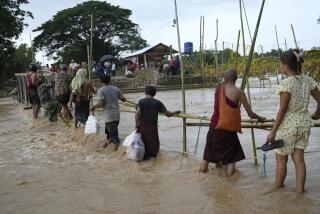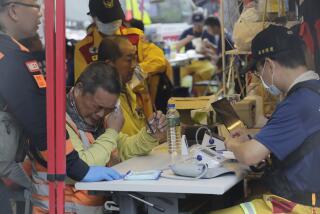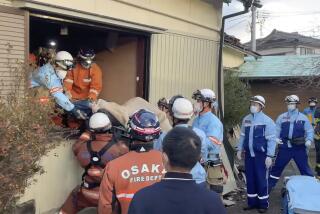At Least 25,000 Die in Tsunami
- Share via
MADRAS, India — The death toll from a massive undersea earthquake that triggered a wall of water crashing through Asia climbed to 25,000 today as officials braced for more deaths and a Herculean cleanup.
Millions of people were reported homeless in a wide swath from Indonesia to the Indian subcontinent. Whole villages were missing and the wreckage was too extensive for any reasonable estimate of the cost beyond many of billions of dollars. It will likely take years to rebuild.
Children and the young were believed to be the largest group of victims, creating the likelihood that the quake’s woes could spread to future generations. Because Asia has a large number of children, many of whom work with their parents, United Nations officials estimated that perhaps half of the dead were children. The young will be an especially high proportion of those who will die from hunger and disease in coming days and weeks, officials said.
At least 27 aftershocks have been reported from the 9.0 Sunday quake in the waters off Indonesia.
Experts warned that the aftereffects were likely to be even more deadly. Disease, spread from rotting corpses, starvation and lack of drinkable water all threaten to keep killing for weeks.
Officials across the region increased the death toll as each grim minute brought new discoveries. Sri Lanka reported more than 12,000 dead; Indonesia put the number of bodies at more than 5,000. India said more than 7,000 had died. Thailand reported almost 1,000 bodies; while Malaysia, Maldives and Myanmar all reported initial death tolls in the hundreds.
Even 3,000 miles away in Africa, Somalia reported hundreds had been killed.
The disaster was an equal opportunity killer, claiming rich Western tourists, impoverished native fishermen and revelers seeking a holiday beach break. The 21-year-old grandson of Thailand’s King Bhumibol Adulyadej was among those killed when the motorized ski he was riding on the ocean was overwhelmed by the towers of water.
The catastrophe began when the earthquake, the world’s biggest in 40 years, struck just before 7 a.m. Sunday beneath the Indian Ocean, 155 miles southeast of Banda Aceh on the Indonesian island of Sumatra.
The quake spawned tsunami waves, some traveling at 500 mph and rising 30 feet into the air. Television images captured the unrelenting sea pouring across deserted beaches, smashing everything from huts to hotels.
The U.S. and the European Union immediately pledged millions of dollars of aid to relief agencies, but it was unclear how quickly any group could deal with the needs.
It will take “many billions of dollars” and a number of years to bury the dead, battle disease and recover, said Jan Egeland, who heads the U.N. Office for the Coordination of Humanitarian Affairs.
The deadly wave probably will have the biggest impact of any natural disaster in the five decades that the United Nations has been coordinating the global response, because it struck so many heavily populated areas, Egeland told reporters.
The tsunami struck a year to the day after an earthquake killed 31,000 and left 100,000 homeless in the Iranian city of Bam. That disaster led to an outpouring of aid.
Officials began organizing airlifts to devastated Asian countries, and in some areas the military was mobilized to bring in supplies.
More than 100 foreigners from 23 countries were reported killed, and perhaps four or five times that number were believed missing, officials said.
For parts of the United States and Europe, the impact was as profound as if it had happened on local streets. People in Asian communities desperately sought information about missing relatives and collected money to send abroad.
The tsunami waves traveled through a region that lacks any warning system. Ocean buoys in a tsunami warning network can alert people to a lethal wave’s approach hours before it hits, giving them time to move to higher ground.
Tsunamis hold a special fear for the West Coast of the U.S. In Oregon, Washington, Alaska and Hawaii, blue-and-white tsunami evacuation route signs remind coastal residents of the danger of gigantic earthquake-driven waves, but California officials have yet to install road signs to show millions of Southern Californians the best routes to refuge.
Possibly the worst-hit country was Sri Lanka, a war-ravaged island off the southern tip of India, where wave after wave of surging tides created rivers of seawater that carried people away along with cars and the rubble of collapsing buildings.
In Indonesia, health officials said more than 4,400 people were killed on Sumatra, most of them in the northern province of Aceh, where entire villages were swept away and bodies were lodged in trees. Many of the dead were children, officials said.
At least eight Americans were among the dead, the State Department said. Hundreds of Americans are reported missing, Secretary of State Colin Powell told reporters in Washington.
The region’s damage was horrific, with each country providing a portrait of its grief.
At least 3,000 people were reported dead, and an additional 2,000 missing, in India’s Andoman and Nicobar islands, which lie just south of Thailand. More than 7,000 are believed dead in five Indian states.
Reporters who flew to the Andoman and Nicobar islands with defense officials and ruling Congress Party leader Sonia Gandhi said 100 air force staff were washed out to sea when tsunami waves struck their airbase.
A reporter with India’s NDTV cable news station channel said a mob of at least 100 people swarmed Gandhi’s car, demanding the government move faster to deliver relief aid.
The Indian navy dispatched two ships to rescue survivors trapped on outlying islands and to help the wounded.
In Cuddalore district, a coastal region around 15 miles south of the former French colony of Pondicherry, local officials ordered at least 175 bodies of Hindus buried in five pits. They refused to allow families to cremate the dead in traditional pyres out of fear that rotting corpses could cause an epidemic of disease.
But the relief effort is picking up pace, and police guarded some abandoned villages to prevent looting.
In Nagapattinam, a district farther south in Tamil Nadu state, medical workers struggled to treat the injured because a government hospital was flooded by the rushing wall of seawater.
Prime Minister Manmohan Singh announced a relief package of more than $116 million to help support survivors and families who lost loved ones. The government promised to pay more than $2,300 to the family of each person killed in the catastrophe.
Southern India is used to dealing with disasters such as tropical storms, but the tsunami waves have caused a calamity on a scale unknown here.
Unlike earthquakes, which cause massive destruction in relatively concentrated areas, the tsunami damage stops around a half a mile inland, but runs for hundreds of miles along India’s eastern coast, and throughout offshore islands like the Andamans.
Military officials in the Andoman and Nicobar islands predict the death toll there could reach 10,000 because the tsunamis swept straight over the islands, washing untold number of people out to sea, according to local reports.
When the waves hit Sri Lanka, anyone who could grab hold of anything that wasn’t moving did so, and clung to it desperately for life, witnesses said. But many lost their grip and were pulled to their deaths.
Sri Lankan officials estimate that 100,000 to 200,000 homes were destroyed, President Chandrika Kumaratunga said in an interview broadcast today.
“We weren’t very well prepared, I have to say, because we have not ever had to face this kind of disaster,” said the Sri Lankan leader, whose country has been locked for 18 years in a civil war with Tamil Tiger separatists.
From rebel-held areas in the north, down the eastern coast to tourist resorts in the south, Sri Lanka suffered widespread devastation. Thousands of people were reported heading for the capital, Colombo, to seek shelter.
Rescue workers told the Reuters news agency that 22 of the dead in Yala were Japanese tourists.
Residents of Kosgoda, 45 miles south of Colombo, described their coastal town as a cemetery.
“There is no Kosgoda, no Kosgoda Village Hotel, no restaurants,” said Jothimune Saman Perera, a 40-year-old tour operator, choking on sobs. “Everywhere there are bodies I have no words to explain.”
Another Kosgoda resident, Kumani de Silva, 20, said a neighbor saw the first wave and warned her to drive away.
“Now all we have left is our clothes and the car. Our new hotel, with the big, blue roof — absolutely everything is gone, only the roof and the inner walls are left. The tuktuk [motorized rickshaw] has disappeared into the water, all the furniture, everything. Our other neighbor, a fat fisherman, is dead.”
In Indonesia, at least 3,000 of the dead were in Banda Aceh, the capital of Aceh province, and officials said the death toll was likely to rise. Communication with many coastal areas was impossible, and the extent of the damage there remained uncertain.
Vice President Jusuf Kalla said the government had dispatched aid officials to the region.
The province has been under strict military control for the last 18 months because of a separatist rebellion.
“We have stopped recovering bodies and will begin again first thing in the morning,” Lt. Col. Belyuni, the military chief for North Aceh district, told El Shinta radio. “It’s possible the death toll will mount because many corpses are still caught up in trees.”
Some residents watched as the waves approached, apparently without realizing the danger, and were swept out to sea, officials said.
Indonesia’s Metro TV station showed a mother screaming and hugging her dead child. In other footage, residents ran in panic through the coastal city of Lhokseumawe.
More than 200 inmates escaped from a prison when a wave knocked down its walls in the town of Pidie in Aceh, Reuters quoted a police official as saying. A few later turned themselves in.
Because it is a tourist haven, Thailand will likely have the largest number of Westerners to die, from Phuket to the coastal region of Phang Nga to the north. Hundreds of tourists were evacuated from Phuket to Bangkok.
Some witnesses said the wave struck Phuket at three stories high and crashed into beach hotels. Afterward, cars and chairs littered the ocean offshore.
Michael Murtaugh, a resident of Phuket, said huge boats that had been resting in the harbor were thrown up side streets along with four-wheel-drive trucks that appeared to have flipped over repeatedly before they came to rest in hotel lobbies, restaurants and shops. The mile of paved beachfront promenade was destroyed, he said.
Murtaugh knew something was wrong when he heard helicopters and planes over Patong Beach for the first time since his arrival in Phuket in May.
“It wasn’t long before people started streaming up our hillside road, dragging their soaked possessions in shock and bewilderment,” he said. Many people were looking for friends or spouses who had disappeared.
On nearby Phi Phi Island, 200 bungalows at two resorts were swept out to sea, along with some of the resorts’ staff and clients, Associated Press said.
Times staff writers Richard C. Paddock in Medan, Indonesia, and Shankhadeep Choudhury in India and special correspondent Nicola Jones in Kandy, Sri Lanka, contributed to this report. Times wire services also contributed.
More to Read
Sign up for Essential California
The most important California stories and recommendations in your inbox every morning.
You may occasionally receive promotional content from the Los Angeles Times.











